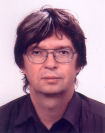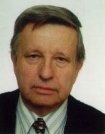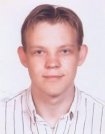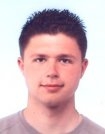Simulations of industrial processes
 The fully automated and computerized metallurgical industry and production are unthinkable without using modern
informational and controlling systems that utilize monitoring and modelling (simulations) of production processes. Our
research group deals with these problems primarily in a relation to the continuous casting process, rolling and other
thermal processes of metallurgical industry. We specialize in all processes comprising phase or structural changes.
The fully automated and computerized metallurgical industry and production are unthinkable without using modern
informational and controlling systems that utilize monitoring and modelling (simulations) of production processes. Our
research group deals with these problems primarily in a relation to the continuous casting process, rolling and other
thermal processes of metallurgical industry. We specialize in all processes comprising phase or structural changes.
The members of our research group are:
Skupinu tvoří:

doc. Ing. Josef ŠTĚTINA, Ph.D. - computer network administrator, specialises in measurement and control with the use of PC (author of control and measuring systems e.g. for Škoda auto company). Lectures Thermodynamics, Seminar on applied thermodynamics, CAD, and Experimental methods. His main specialisation is design and programming of measuring and control systems for metallurgy, automotive industry, and building technology.

prof. Ing. František KAVIČKA, CSc. - the founder of the discipline at BUT. His contemporary concerns are with material aspects of the discipline.

Ing. Tomáš MAUDER - PhD student whose research focuses on “Optimisation of continuous steel slab casting with the use of the temperature field numerical model”.

Ing. Lubomír KLIMEŠ - PhD student whose research focuses on “Optimisation of secondary cooling parameters of continuous steel casting“.
References (listed follows the works were our models are in operation)
- Evraz Vítkovice Steel a.s. Ostrava, Česká republika - modelling and control of continuous steel slab casting implemented
- Třinecké železárny a.s. Třinec, Česká republika - modelling and control of billet casting of steel implemented
- US Steel, Košice, Slovensko - off-line model of continuous casting of steel applied to continuous slab casting
- Železárny Podbrezová, Slovensko - pilot application of the off-line model of continuous casting of steel on billet continuous casting
Co-operating organisations:
- Heat transfer and fluid flow laboratory
- School of business administration in Karviná of the Silesian University in Opava
- Department of thermal engineering of the Technical University of Ostrava
PhD and habilitation theses originated by the group:
- Dynamic model of the temperature field of the continuously cast slab
- Optimisation of continuous steel billet casting with the use of the temperature field model
- PhD thesis by Tomáš Mauder - Optimisation of continuous steel slab casting with the use of the temperature field numerical model
Production optimization the basis for Industry 4.0
 Can show what happened if server is breakdown, the queue is limited, new server is add or removed in the line,
…
Simulation can train the machine operators how to react on nonstandard or breakdown situation
Can help with new production line proposal
Industry 4.0
Contact: mauder@fme.vutbr.cz , stetina@fme.vutbr.cz
Can show what happened if server is breakdown, the queue is limited, new server is add or removed in the line,
…
Simulation can train the machine operators how to react on nonstandard or breakdown situation
Can help with new production line proposal
Industry 4.0
Contact: mauder@fme.vutbr.cz , stetina@fme.vutbr.cz
Whole Article 13. 08. 2016 | Author prof. Ing. Josef ŠTĚTINA, Ph.D.
Transient simulation temperature field for continuous casting steel blank
 The solidification and cooling of a slab, and the simultaneous heating of the mold, is a case of transient
spatial–or three-dimensional–heat and mass transfer.
The solidification and cooling of a slab, and the simultaneous heating of the mold, is a case of transient
spatial–or three-dimensional–heat and mass transfer.
Whole Article 22. 09. 2013 | Author prof. Ing. Josef ŠTĚTINA, Ph.D.
http://www.issisteel.org/
 The International Society of Steel Institutes (ISSI) was formed in 2006 to promote collaboration between
national institutes and societies which are engaged in promoting knowledge in the field of iron and steelmaking, steel
usage and properties.
The International Society of Steel Institutes (ISSI) was formed in 2006 to promote collaboration between
national institutes and societies which are engaged in promoting knowledge in the field of iron and steelmaking, steel
usage and properties.
Whole Article 13. 02. 2013 | Author prof. Ing. Josef ŠTĚTINA, Ph.D.
Conference participation planned
Whole Article 20. 01. 2013 | Author prof. Ing. Josef ŠTĚTINA, Ph.D.
Taking part in METAL 2013 conference
22 nd International conference on metallurgy and material 15- 17 May 2013 at the Voroněž I Hotel, Brno, Czech Republic
Whole Article 20. 01. 2013 | Author prof. Ing. Josef ŠTĚTINA, Ph.D.
Programming support for engineering problems

Whole Article 23. 11. 2012 | Author prof. Ing. Josef ŠTĚTINA, Ph.D.
Ing. Lubomír Klimeš – Treatise on Optimisation of secondary cooling parameters of continuous steel casting
 The presented treatise submitted for the state doctoral exams deals with stochastic optimisation of operational
parameters of continuous casting of steel facility. It presents the state of the art of the continuous casting of steel
technology, numerical models of temperature fields of blanks produced by the technology, parallelization opportunities,
optimisation methods and algorithms for solution of engineering problems, especially of random and/or uncertain
character. The emphasis is put on control volume method, progressive hedging algorithm that enables for solution to
stochastic optimisation problems, and CUDA architecture. The treatise also covers the actual state report on progress
of the PhD study, achieved intermediate results included. It concludes with setting the study goals and methodology
applied to fulfil the goals.
The presented treatise submitted for the state doctoral exams deals with stochastic optimisation of operational
parameters of continuous casting of steel facility. It presents the state of the art of the continuous casting of steel
technology, numerical models of temperature fields of blanks produced by the technology, parallelization opportunities,
optimisation methods and algorithms for solution of engineering problems, especially of random and/or uncertain
character. The emphasis is put on control volume method, progressive hedging algorithm that enables for solution to
stochastic optimisation problems, and CUDA architecture. The treatise also covers the actual state report on progress
of the PhD study, achieved intermediate results included. It concludes with setting the study goals and methodology
applied to fulfil the goals.
Whole Article 15. 08. 2012 | Author prof. Ing. Josef ŠTĚTINA, Ph.D.
Tomáš Mauder – PhD thesis on Optimisation of continuous steel slab casting with the use of the temperature field numerical model
 The thesis concerns with optimisation of operation of continuous steel slab casting facility. It summarises
fundamental analytical and empirical findings about the solidification process, numerical modelling and selected
optimisation techniques. It also states the physical conditions and factors influencing the final quality of steel,
including their mutual interactions. The solution is based on an original off-line numerical model of the temperature
field and its validation against real operation data. The model is extended by an optimisation fuzzy logic based model
which is applied to optimisation of the process control. Its versatility is demonstrated by several cases e.g. finding
the right casting parameters to produce high quality steel, reaction to emergency situations, finding the optimum
relationship between individual casting parameters etc. Within the frame of the optimisation results, the thesis
analyse recommended changes to the casting line of a particular continuous casting facility with the aim to reach
higher surface temperature of the blank around straightener rolls. The entire concept of the numerical and optimisation
model is general to such extent that it is applicable to any slab or billet steel casting.
The thesis concerns with optimisation of operation of continuous steel slab casting facility. It summarises
fundamental analytical and empirical findings about the solidification process, numerical modelling and selected
optimisation techniques. It also states the physical conditions and factors influencing the final quality of steel,
including their mutual interactions. The solution is based on an original off-line numerical model of the temperature
field and its validation against real operation data. The model is extended by an optimisation fuzzy logic based model
which is applied to optimisation of the process control. Its versatility is demonstrated by several cases e.g. finding
the right casting parameters to produce high quality steel, reaction to emergency situations, finding the optimum
relationship between individual casting parameters etc. Within the frame of the optimisation results, the thesis
analyse recommended changes to the casting line of a particular continuous casting facility with the aim to reach
higher surface temperature of the blank around straightener rolls. The entire concept of the numerical and optimisation
model is general to such extent that it is applicable to any slab or billet steel casting.
Whole Article 26. 07. 2012 | Author prof. Ing. Josef ŠTĚTINA, Ph.D.
Steel production schematics
 How steel is produced nowadays.
How steel is produced nowadays.
Whole Article 20. 05. 2012 | Author prof. Ing. Josef ŠTĚTINA, Ph.D.
Taking part in METAL 2012 conference
The international conference METAL 2012 commences on 25 May 2012 at 9:30 at the Voroněž I hotel, conference hall A.
Whole Article 20. 05. 2012 | Author prof. Ing. Josef ŠTĚTINA, Ph.D.
19th Conference on materials and technology
Whole Article 02. 03. 2012 | Author prof. Ing. Josef ŠTĚTINA, Ph.D.
Taking part in METEC InSteelCon 2011 conference
 Our group participated in the conference and trade show METEC InSteelCon 2011, Dusseldorf, Germany, 27 June to 1
July 2011.
Our group participated in the conference and trade show METEC InSteelCon 2011, Dusseldorf, Germany, 27 June to 1
July 2011.
Whole Article 01. 03. 2012 | Author prof. Ing. Josef ŠTĚTINA, Ph.D.
Off-line Dynamic model of solidification
 test
test
Whole Article 01. 03. 2012 | Author prof. Ing. Josef ŠTĚTINA, Ph.D.
On-line dynamic model of solidification
 The on-line model solves for the temperature fields in real time, which requires high performance computational
hardware synchronised with the employed software. As a consequence, the model is capable of monitoring the temperature
field development in the crystallizer area as well as in regions of secondary and tertiary cooling and apply the
gathered information to optimise control of continuous casting facility as a whole and/or of its key
parts/nodes/joints/components .
The on-line model solves for the temperature fields in real time, which requires high performance computational
hardware synchronised with the employed software. As a consequence, the model is capable of monitoring the temperature
field development in the crystallizer area as well as in regions of secondary and tertiary cooling and apply the
gathered information to optimise control of continuous casting facility as a whole and/or of its key
parts/nodes/joints/components .
Whole Article 26. 02. 2012 | Author prof. Ing. Josef ŠTĚTINA, Ph.D.



